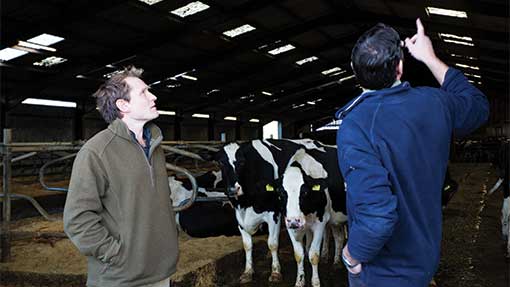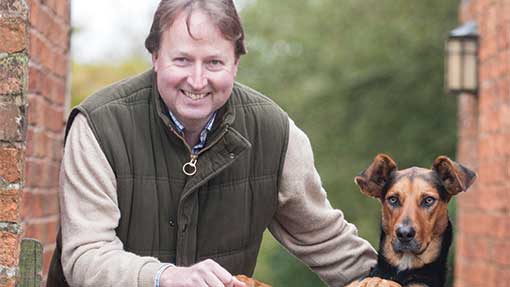Farm Energy Challenge (part 2): Client promotion

Reducing energy wastage can slash farmers’ costs of production, often without the need for significant capital expenditure. We find out how in the first of a new four-part series.
Farmers Weekly has teamed up with E.ON to run the Farm Energy Challenge – a series of features in which two farmers attempt to reduce their energy bills. In this first article, we profile the farmers taking part, and find out about their existing energy usage.
Charleston Farm, Firle, Sussex
Tom Gribble farms in partnership with his father Ed, and took on the Farm Business Tenancy at Charleston Farm, Firle, Sussex, in 2003. They were granted a 20 year FBT in 2010 and have since built up the milking herd to 180 pedigree Holsteins yielding 8,840 litres a year.
Most of the farm buildings and equipment are virtually unchanged since they were installed in the 1970s, although recent improvements have included new sand cubicles and silage clamp walls.
Tom and his herdsman Adrian milk the cows twice a day, and recently switched to housing them all year round, with the exception of late lactation and dry cows. “We have so little grass from July onwards that we were feeding almost a complete ration all year round anyway,” says Tom. “So we decided to keep the cows indoors throughout most of their lactation.”
The cows calve outside from 1 July to the end of October, with all stock housed over the winter, and dry or late lactation cows turned out in March or April. As a result, Tom’s electricity bills are higher this year than previous years, totalling about £6,800 including VAT. “Compared to what we spend on feed, electricity bills are really not that big,” he says. “But I will be interested to see what the energy audit throws up – obviously, any savings we can make through reducing wastage will be worthwhile.”
Tom has already put in place a couple of cost-saving measures, including new pulsators in the 16×16 herringbone parlour, a water softener to reduce limescale-related filament breakages in water heaters, and, most recently, a borehole. “Our water costs were £12,000-13,000 a year. The borehole has cost us just over £20,000 to put in, but should pay back within less than two years,” he adds.
However, his grasp on energy usage is less secure. “I think we’re probably about average for a dairy farm – lighting is likely to be our greatest cost,” he says. The main cow shed, which houses 200 cubicles, has 12 old fluorescent strip lights that are turned on from 5pm until about 8am, and again in the afternoon. The parlour has separate lighting, and exterior lighting runs on a photocell sensor, turning off during daylight hours.
“If it were up to me, without having an audit, I would probably replace the lighting with newer, energy efficient versions – and I’d like to reduce the milking time a bit,” says Tom. “We spend about three hours on each milking and I want to increase to 200 cows – but I think with this parlour we’ll be limited to 180. We could probably make other energy savings in the parlour, as it’s quite old, but I think that would require quite a lot of money.”
As an Arla Tesco supplier, Tom is sure that reducing energy wastage and carbon footprinting will become increasingly popular in the future. “However, we can’t cut things so far that the farm can’t function; the cows are not machines. I think our costs of production are pretty close to the bone already – when we started out milk prices were 17p/litre so we are used to tight budgets,” he says. “It’s just about farming in as simple and efficient a manner as possible.”
Charleston FARM FACTS
- 180 dairy cows plus replacements. Housed year-round
- 1,400 acres, including 900 acres grass and 500 acres arable on a separate unit
- Also bring on 700 Mule gimmer lambs and lamb 150 Mule ewes on the South Downs
- Baseline energy usage: 71,957 kWh/year
Northfield Farm, Cold Overton, Rutland
A former investment banker, Jan McCourt moved to Northfield Farm, Cold Overton, Rutland, 20 years ago, and has used his experience of London to set up a thriving retail business. Rearing his own rare breed cattle and pigs, and sourcing other high quality meat and produce, he has a farm shop, two catering trailers, a permanent stall at Borough Market and a weekly pitch at Broadway Market in London.

Having set the business up on a shoestring, much of the equipment was second hand when he bought it in 1997, and energy efficiency has not been at the top of the priority list. “We spend between £12,000 and £14,000 a year on electricity – the fridges and freezers take an awful lot of powering,” he says. “When you’re just starting out, you do things bit-by-bit. We were very hand-to-mouth for a long time, so energy efficiency didn’t really come into it.”
As well as the farm shop, Jan has a butchery and processing room, producing fresh food to sell either raw or cooked through his various retail outlets. His 50 White Park, Aberdeen Angus and Dexter suckler cows are housed over the winter, with five British Lop sows and a boar also housed in winter. “We calve the cows year-round, but my son Leo is building the herd up so we’re looking to move more towards spring calving,” he says.
Energy costs for the livestock are minimal, with just lighting over the winter, and heat lamps for the piglets. “It’s the processing and retail side of things that costs a lot to run. In the farm shop we have lighting, fridges, an immersion heater for the water, and display units, which are extremely power hungry,” says Jan. The processing room has mixers, sausage machines and other cooking equipment, as well as an immersion heater and oven. “We’ve also got a large walk-in freezer, an outdoor office with heaters and computers, and two business units which we let out to a sloe gin maker and a renewable energy business.”
Refrigeration and hot water are likely to be the farm’s greatest consumers of electricity, but Jan is unsure how to reduce wastage without large capital outlay. “We use a lot of hot water as we’re always cleaning down – the immersion in the shop is on 24/7, while the one in the processing room is only on when we need it. But I don’t know if that’s the most energy efficient way to run them or not.”
The old refrigerated display cabinets use a lot of electricity, and without doors lose a lot of chilled air, he adds. “The motors also produce a lot of heat; we insulated the first farm shop but it was so hot in there that we didn’t insulate the next building we converted, which probably isn’t ideal either.”
With the fridges and freezers quite prone to breakdowns, Jan has become a bit of an expert in fridge technology. “I’m very tuned into the sound of the compressors running, as that’s usually the first sign of a problem,” he says. “I try and keep the condenser fins clean as that dramatically affects how it works, and have ventilated the shed that houses the walk-in freezer to improve the air transfer. I also replaced the door seals and the motor a couple of years ago.”
But the biggest problem is Jan doesn’t know exactly where his energy is being used. “It would be great to have some form of visible monitor, to get a grip on precisely which bit of equipment is using what. When you’re busy in business, trying to make ends meet, you don’t get the time to sit back and really look at what’s happening with energy consumption.”
Northfield FARM FACTS
- 130 acres of grassland
- 50 suckler cows, housed in winter
- Five breeding sows, housed in winter
- Farm shop, butchery, two business units, and catering trailers
- Baseline energy usage approximately 110,000kWh/year
Read the other Farm Energy Challenge articles:
For more information on farm-specific energy saving ideas, visit E.ON’s Energy Toolkit at eonenergy.com/fw
If you would like an Eon expert to give you advice on how to save energy, please contact Eon at www.eonenergy.com or call 0800 655 788

